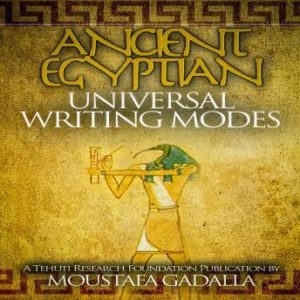Ancient Egyptian Universal Writing Modes Audiobook (Free)
Summary:
This book will show how the Egyptians had various modes of writings for various purposes , and how the Egyptian modes were falsely designated as ‘separate languages’ owned by others and how that one original language had become called Greek, Hebrew, Arabic and other ‘languages’ through the entire world-through deterioration of sound values via ‘sound shifts’, aswell as foreign degradation of the original Egyptian writing forms. The book is split into seven parts with a complete of 24 chapters, about Ancient Egyptian Universal Composing Modes as follows: Part I. Denial, Distortion and Diversion offers 3 chapters-Chapters 1 to 3: Chapter 1: The Archetypal Primacy of The Egyptian Alphabet shows the function and remote history of alphabetical letter-forms composing in Old Egypt ahead of any other place on globe. Section 2: The Concealment of The Supreme Egyptian Alphabets will present the incredible traditional western academia structure to conceal the Ancient Egyptian alphabetical letter-forms from its prominent position in the annals of writing. Section 3: The Diversion of A Proto-Sinaitic ‘Phoenician Connection’ will uncover all the factual statements about having ‘Phoenicians’ as the inventor of alphabets with an Egyptian dirt! Part II. Development and Forms of Egyptian Alphabetic Writings provides 6 chapters-Chapters 4 to 9: Chapter 4: Genesis of Egyptian Alphabetic Letters/Writing Section 5: The Egyptian Sound Company of Letters will cover the primary three vowels as the originators of all vowel sounds and associated consonants. Section 6: The Egyptian Alphabetic Composing Styles will straighten out present common misunderstandings of Old Egyptian varieties of writing and set the two primary designs as uncials and cursive. Section 7: The Occupation of Egyptian Scribes covers the range of Egyptian writings; the career of scribes; composing surfaces & musical instruments; etc Chapter 8: Multiple Writing Forms of a Single Document Section 9: Multiple Composing Types of The Rosetta Stone Part III. THE WAY THE One World Language Became The Many offers five chapters-Chapters 10 to 14: Section 10: The Beacon from the Old World Chapter 11: Common Characteristics of Old Egyptian Alphabetic Composing System Section 12: Letter-forms Divergence of Globe Alphabets From Its Egyptian Source Chapter 13: Audio Divergence of World Alphabets From Its Egyptian Source Chapter 14: Cavalier Designations of New Languages will cover what sort of new language is awarded as a symbol of identification for winners of wars and new religions; etc Component IV. THE PRINCIPAL Linguistic Characteristics of The Egyptian Language offers one chapter-Chapter 15: Chapter 15: The Primary Linguistic Characteristics from the Egyptian Language Component V. Out of Egypt-Diffusion Patterns To Asia and Africa provides 5 chapters-Chapters 16 to 20: Section 16: Hebrew and Moses of Egypt Chapter 17: The Old Egyptian Hegemony of Asiatic Neighbors will discuss the discovered scripts in North and South Arabia; and get rid of all apparent differences between them as well as the Ancient Egyptian composing system. Section 18: The African Connections Chapter 19: From Egypt To India and Beyond Chapter 20: From Egypt towards the Black Sea Basin [Georgia & Armenia] will cover affinities of languages from Central Asia Towards the Black Sea Basin; etc Part VI. Out of Egypt-Diffusion Patterns To Europe provides two chapters-Chapters 21 & 22: Section 21: Greek: A Shameless Linguistic Heist will cover the pre-existence from the proclaimed ‘Greek’ alphabetical letter-forms in the Ancient Egyptian program; the absence of any linguistic distinction between Greek as well as the Ancient Egyptian vocabulary;etc Chapter 22: The Western european Languages will cover Etruscan, Latin and Hispanic languages; and the lack of any linguistic variation between them and the Old Egyptian language. Component VII. The Ancient Future of The Universal Language offers two chapters-Chapters 23 & 24: Chapter 23: Egyptian Alphabetical Vocalic Language [History, Present & Future] Section 24: Renaissance & Seeking the General Language.
Related audiobooks:







